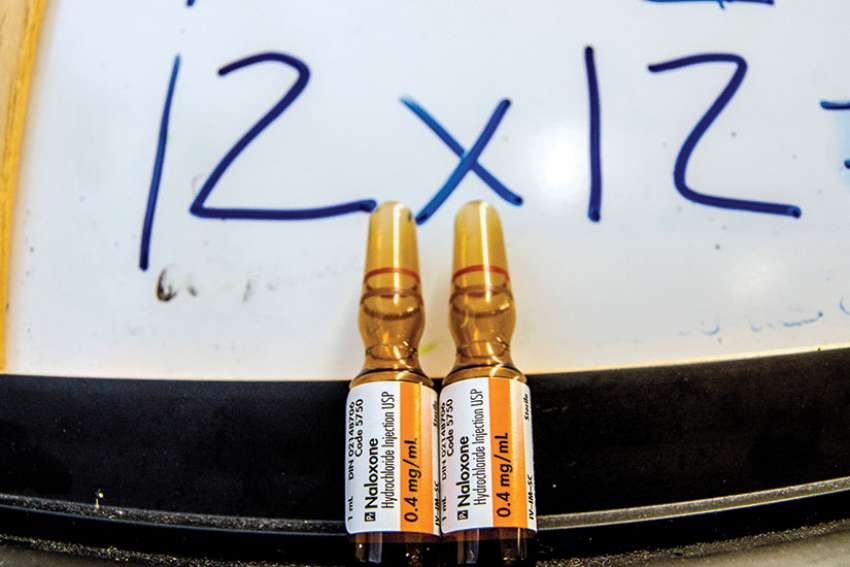“The Ottawa Catholic School Board has committed to purchasing the nasal spray form of Naloxone for each of our high schools,” said Mardi de Kemp, a spokesperson for the board. “(That way) in the case of an overdose the Naloxone nasal spray is available if needed to be administered prior to the arrival of emergency staff personnel.”
The move comes as opioid-related deaths continue to rise in the province. In the last 15 years, the number has more than quadrupled, to 735 in 2015. Nationwide, the number climbed to 2,448 deaths due to pain-killing drugs.
The Ontario government ramped up its response to the opioid crisis on June 12 with a vow to hire more front-line workers for local boards of health and to equip communities wih 6,500 additional Naloxone kits per month.
On Valentine’s Day this year, 14-year-old Chloe Kotval, who attended All Saints High School in Ottawa, died in hospital two days after her mother found her unresponsive due to an apparent opioid overdose. Her death came one day after Ottawa Public Health had issued a warning about counterfeit prescription pills believed to have caused “recent life-threatening overdoses” in the city.
Opioid overdoses, besides being potentially fatal, can cause pulmonary conditions, cardiac complications, muscular problems, neurological disorders and cognitive impairment due to the brain being deprived of oxygen for extended periods of time. After just three minutes without oxygen serious brain damage is likely and after 10 minutes recovery is unlikely.
Signs of an opioid overdose include lips and fingernails turning blue, shallow or stopped breathing, and being unresponsive.
Naloxone, sometimes referred to by the brandname Narcan, is a fast-action opioid antidote that works by displacing opioids from the receptors in the brain for about 45 minutes.
Although intramuscular injectable Naloxone can be acquired for free with a valid Ontario Health Card from pharmacies across the province — it took The Catholic Register 30 minutes to obtain both the kit and training from Shoppers Drug Mart in Toronto — Kemp said the board opted for the easier-to-use nasal spray, which costs about $75 per unit.
“The view was that the nasal spray is less intrusive for administrators to administer and does not require an intramuscular needle nor the drawing of naloxone into the syringe,” she said. “On a case to case basis, (however), if a student or parent has informed office staff that a student at the school is carrying a personal Naloxone kit we would then also have the required staff trained on the use of the intramuscular version.”
Naloxone has “minimal side effects” and will not adversely affect anyone who is mistakenly given the drug, said the Canadian Centre on Substance Abuse in a 2016 publication.
The centre cited a 2011 study which found that 14 per cent of Ontario’s students in Grades 7 to 12 had used prescription opioids for non-medical reasons at least once in the previous year. Prescription opioids ranked third in the study, behind alcohol and cannabis.
In addition to stocking Naloxone, the Ottawa board is also working with Ottawa Public Health to “focus on preventive measures,” said Kemp.
On May 30, the Catholic District School Board of Eastern Ontario announced that it, too, would be purchasing the nasal sprays and expects to have it available in all of its schools for September.
In British Columbia, dubbed “ground zero” of the opioid epidemic where 922 opioid-related deaths occurred in 2016, half a dozen school districts are already in possession of Naloxone with another six preparing to follow suit.
Those decisions were influenced by a coroner’s inquest into the March 2016 death of 20-year-old Brandon Jansen, who died of an opioid overdose while receiving treatment in an inpatient addictions rehabilitation facility. The inquiry resulted in 21 recommendations, including having Naloxone kits available in schools and training staff to administer it.
Both Toronto Catholic and the Dufferin-Peel Catholic District School Board said they have no plans currently to change their procedures in the event of an on-site overdose.
“We take our direction from the Ministry of Education and, on health matters, from our regional health authorities,” said Bruce Campbell, a spokesperson for Dufferin-Peel. “To date we have not been made aware of any direction on the stocking of Naloxone/Narcan kits, the appropriateness for student use, for what ages ... from either the Minister or the medical officers of health of our jurisdictional health authorities. We are, however, well aware of and are following with interest, the fentanyl/carfentanyl issue.”
The Ministry, meanwhile, says “local school boards are responsible for decisions regarding the distribution of substances like Naloxone.”
The province’s Catholic teachers union would prefer to leave emergency medical care in the hands of the professionals.
“It is important to remember that teachers are not medical professionals,” said Ann Hawkins, president of the Ontario English Catholic Teachers’ Association. “We do not believe that we are in the best position to deliver medications and medical procedures.”
Sean O’Leary, an Ottawa-area parent whose daughter struggles with drug addiction, said delaying the implementation of Naloxone into schools puts students at risk.
“It’s not right. It doesn’t make sense,” O’Leary, a member of We the Parents, told the CBC. “They have EpiPens for kids that may have an allergic reaction, they have CPR training, yet if a kid overdoses they’re essentially waiting for first responders to get there.”



